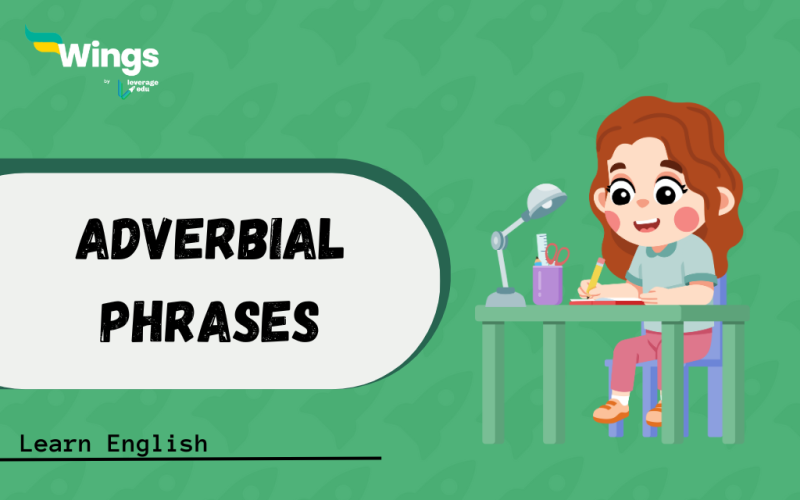Adverbial Phrases: Imagine yourself forming a sentence as painting a canvas. You will use the colour of verbs to imprint the main subject, while the paintbrushes called adverbs will give a strong definition to those colours. But, Adverbial phrases take it a step further and are like a whole tool kit. They are such impressive English words that work together to modify the verb in more precise and interesting ways.
However, to own that painting tool kit called adverbial phrases, you would first need to differentiate them from adverbial clauses, and learn how to form and use them through examples. Therefore, let’s find out more about this tool in this blog and hone your skills to be at par with a grammar nazi.
This Blog Includes:
What are Adverbial Phrases?
When you have to define adverbial phrases, you can think of them as a mini-sentence tucked inside your main sentence. As per the standard definition, they are also referred to as a group of words that take the role of a verb in a sentence. Thereafter, it describes a verb, adjective, and sometimes even another adverb for easy comprehension.
So, just in case you are looking for an answer for ‘how, when, where, or when’ within a sentence, the adverbial phrases need to be there.
For Example, Sarah arrived at dawn.
[Note how the verb ‘arrived’ is backed by the phrase ‘at dawn’. It elaborates on when the action has taken place.]
Learn all about Adverbs – Definition, Types, Use Here!
How to Form Adverbial Phrases?
Before focusing on the rules to form adverbial phrases, you should first go through the types of adverbs. It will help you to master its usage like a native English speaker and avoid any potential English errors. For now, you can steal a glance at the table below and quickly move forward to the learning rules.
| Types | Usage | Example |
| Time | When something happens | He arrived shortly afterwards. |
| Place | Where something happens | They walked hand-in-hand along the beach. |
| Manner | How something happens | He typed furiously. |
| Reason | Why something happens | They left in search of food. |
| Degree | How much/to what extent something happens | The sun shone brightly. |
Rules to Form Adverbial Phrases
Now, let’s find out how to form adverbial phrases without harming any grammatical rules.
- Position: They can be placed in various positions in a sentence, but to be precise, they come before the verb they modify, after the verb, or at the end of the sentence.
- Commas: When an adverbial phrase interrupts the flow of the sentence, especially at the beginning, use a comma to set it off.
- Conciseness: Aim for clarity and avoid overly long or convoluted phrases.
Find out more reads on grammar rules below!
| 5+ Golden Rules for Prepositions | 10 Article Rules with Examples |
| Tenses Rules | Degree of Comparison Rules |
Adverbial Phrases Example Sentences
Next, check out these example sentences of adverbial phrases for further understanding of their types and rules from the discussions above:
- She silently crept through the shadows, her footsteps barely a whisper. (Manner)
- The train hurtled across the countryside, reaching its destination just before dusk. (Time)
- They huddled around the crackling fire, sharing stories and laughter. (Place)
- Driven by ambition, she pursued her goals with unwavering determination. (Reason)
- The music faded like a breath of wind, leaving a hush in its wake. (Simile, Manner)
- He spoke with a heavy heart, his voice thick with emotion. (Manner)
- They waited patiently for the news, Esperanza flickering in their eyes. (Manner)
- The sun dipped below the horizon, painting the sky with hues of orange and purple. (Manner)
- They walked hand-in-hand along the beach, their footprints disappearing in the sand. (Manner, Place)
- Lost in thought, she wandered through the maze of bookshelves, drawn by the scent of old paper. (Manner)
Adverb phrases in English || Adverbial phrases || A must watch lesson
Difference Between Adverbial Phrases and Clauses
So far, you might have gained confidence in using adverbial phrases through the implication of examples and rules. But, sometimes they can be confused with clauses, given their overlapping functionality. After all, they both modify verbs, adjectives and other adverbs.
Therefore, let’s not tumble upon their identification in future and find out more about their similarities and differences hereon.
| Criteria of Analysis | Adverbial Phrases | Adverbial Clauses |
| Definition | Group of words acting like an adverb to modify verbs, adjectives, or other adverbs. | Group of words acting like an adverb with a subject and verb of its own. |
| Difference | No subject or verb of its own | Functions like a mini-sentence |
| Example | At midnight | When the clock struck twelve |
Explore more reads on Adverbs below!
| Interrogative Adverbs | Adverbs of Frequency |
| Conjunctive Adverbs | Adverb of Time |
| Adverbs for Manner | Adjective vs. Adverb |
This was all about the Adverbial phrases, its rules and examples. Hopefully, you found it to be helpful and informative. For more such informative reads, stay tuned to Leverage Edu!
 One app for all your study abroad needs
One app for all your study abroad needs














 45,000+ students realised their study abroad dream with us. Take the first step today.
45,000+ students realised their study abroad dream with us. Take the first step today.

